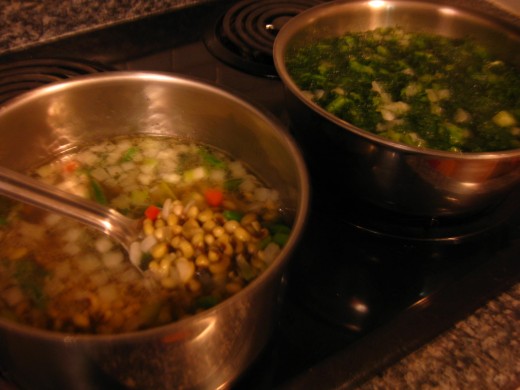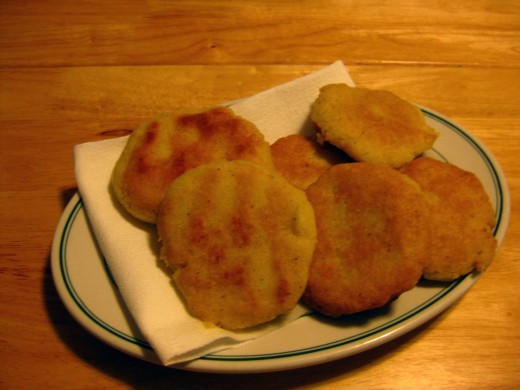Deep South USA Tradition: Blackeyed Peas and Greens
Blackeyed peas and greens cooking on my stovetop

Why eat blackeyed peas and greens?
Growing up in the Deep South of the USA, I've always been accustomed to eating blackeyed peas and greens (usually mixed turnip and mustard greens, sometimes with added collard greens) on New Year's Day. I recall my grandmother telling me this meal would bring good luck and prosperity during the coming year. As a child I didn't question her statement. Besides, I absolutely loved blackeyed peas, greens and the scrumptious cornbread that accompanied them.
It wasn't until mid-adulthood that I wondered about this practice and did a bit of research to find out the why the tradition began. It seems this southern tradition didn't originate in the southern United States at all!
In fact, centuries before the custom began here, Jewish peoples (Sephardic and Israeli Jews) ate blackeyed peas, among other foods, during the Jewish New Year as symbols of good luck. When Sephardic Jews immigrated to the American state of Georgia in the early 18th century, they brought the custom along with them.
You guessed it! We southerners "borrowed" the tradition from our new neighbors. The dishes got a bit of dressing up by southern cooks, who (apart from vegetarians and vegans) can't seem to cook vegetables without adding pork and, often, sugar. The peas, cooked in water with salt, pepper, and diced onions, got an addition of bacon, ham, hog jowls or fatback to impart that "down-home" southern flavor.
I don't eat pork, so I leave out that ingredient. Salt, pepper, onions, a bit of chopped celery and red bell pepper, plus a pinch of garlic powder make my dish of New Year peas quite flavorful and "down-home" enough for me, thank you. Greens cooked slowly seasoned only with salt and pepper taste delicious. A few chopped turnip roots may be added to bump up the flavor. Purists in the Deep South call for red-hot sauce to be eaten with greens, but I gave up the hot sauce a few years back along with the heartburn it engendered.
I round out the New Year's Day meal with thin skillet-fried cornbread patties. These are made by pouring boiling water over stone-ground cornmeal that has salt and baking powder mixed thoroughly into it. The hot water swells the meal into a mush. When it cools sufficiently to handle (hurried along by putting the bowl in the refrigerator for about fifteen minutes), I wet my hands--just as my grandmother did--so I can handle the cornmeal mixture without it sticking to me.
I shape small flat patties that brown quickly in a skillet with oil barely covering its bottom surface. My preferred oil is extra virgin olive oil, so I keep the burner on medium heat. After flipping each patty and letting the second side brown, I lower the burner heat to let the middle of the skillet cornbread cook. I never time this step, but can tell if the patties are ready by pressing them with a spatula. If no mush oozes out, they're good to go. Once done, they're placed on several layers of paper toweling so any excess oil will drain.
Mmm...these are good! They're terrific whether eaten while still warm or leftover and cold. (They make good snacks if any last until the next day.) In fact, I can't allow myself to cook these delicious little skillet cornbread patties very often because I'll eat too many and gain weight.
Our New Year's Day meal is ready. I'm not superstitious, but I've been keeping this ritual for well over half a century now. It's a part of who I am, so why should I stop? I certainly don't think my luck will be bad in the upcoming year if I don't eat the traditional New Year's Day meal, but why should I miss out on such a delicious dinner? This is really good eating, no dessert needed, just iced tea with lemon in a big glass. For those who sampled all the sweets on the sideboard during holiday feasts, this meal of peas, greens and cornbread pampers the over-indulged palate.
By the way, you needn't wait for New Year's Day to enjoy blackeyed peas, greens and cornbread. This meal tastes wonderful year-round.

What's Your New Year's Meal?
Does your part of the world have a special meal that's traditional for New Year's Day? If your background is German or Polish, you may partake of herring, which symbolizes a bountiful catch. Other nationalities choose a different fish, the symbol of fertility.
The Spanish custom of eating twelve grapes as the clock is chiming midnight is another food tradition for New Year's. Each grape symbolizes one month in the coming year, and one must eat all twelve grapes before the clock stops striking. If a grape tastes sweet, that month will be good; if sour, it will be a bad month.
Lentils, like our southern blackeyed peas, are another food enjoyed by many cultures for luck and prosperity because they are round like coins. Sauerkraut with pork marks the beginning of a new year in a Pennsylvania Dutch tradition. In fact, many cultures serve pork for New Year's Day. (I wonder what vegetarians or vegans in those cultures eat instead.)
Many Asian countries serve soba noodles (long noodles) for the New Year meal, to symbolize long life. Included in the tradition is to not let a noodle break before it's inside one's mouth.
In Mediterranean countries, pomegranates eaten at the New Year are associated with abundance and fertility.
The Irish enjoy green cabbage--the color of money--in hopes of a prosperous year.
It's an old custom in Scotland that the first visitor to one's home in the new year is expected to bring a cake--either shortbread or dark fruitcake. In return, the guest is given food and drink.
If you eat a special food on New Year's Day, it is likely the result of your family heritage. If you observe such a cultural tradition, whether for good luck, prosperity, or (fill in the blank), please share it with readers in the comments section.
And to everyone...I wish you good eating and a wonderful new year!
Thanks for reading and supporting this HubPages writer!
---------------
Please vote and leave comments. Your feedback is valuable to me.
NOTE: I am the author of this article, and it is owned by me in entirety.It is not available for use by reproducing in any form without my express written permission. If you see all or any part of this article (as written) on another site, please notify me where it can be found. Theft of a writer's work is plagiarism, and stealing another's words is no less wrong than any other theft.
---------------
© 2011 Jaye Denman






